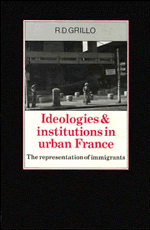Book contents
- Frontmatter
- Contents
- List of tables, figures, and maps
- Acknowledgments
- Glossary of abbreviations and acronymns
- 1 Introduction
- 2 Immigrants in France and in Lyon
- 3 Two modes of discourse: immigrés and étrangers
- 4 Urban development and the problems of housing: the “bachelors”
- 5 Housing and the “problems” of immigrant families
- 6 North African women and the French social services
- 7 In the schools and on the streets
- 8 Language
- 9 Work
- 10 “The strike is like a school”
- 11 The representation of problems and the problem of representation
- 12 Conclusion: institutional and ideological structures
- Appendix: The French school system
- Bibliography
- Maps
- Index
5 - Housing and the “problems” of immigrant families
Published online by Cambridge University Press: 27 August 2009
- Frontmatter
- Contents
- List of tables, figures, and maps
- Acknowledgments
- Glossary of abbreviations and acronymns
- 1 Introduction
- 2 Immigrants in France and in Lyon
- 3 Two modes of discourse: immigrés and étrangers
- 4 Urban development and the problems of housing: the “bachelors”
- 5 Housing and the “problems” of immigrant families
- 6 North African women and the French social services
- 7 In the schools and on the streets
- 8 Language
- 9 Work
- 10 “The strike is like a school”
- 11 The representation of problems and the problem of representation
- 12 Conclusion: institutional and ideological structures
- Appendix: The French school system
- Bibliography
- Maps
- Index
Summary
IMMIGRANT FAMILIES IN LYON
It is impossible to be precise, but it is indisputable that between 1968 and 1975 there was a significant increase in the numbers of immigrant families in the Lyon area. A comparison of prefecture data for 1969 and 1975 would suggest that the child population of Algerians, Moroccans, Tunisians, and Portuguese rose by more than 50 percent in that period. It is probable, in fact, that the prefecture's count of North African children seriously underestimates the true picture, as does the official figure of about 8,000 North African families in the Rhône for the mid-1970s.
My own best guess of up to 10,500 North African families takes into account marriages established in France between French citizens and foreign spouses – almost all of which involve North African men marrying or establishing conjugal households with French women. Zehraoui (1971) has estimated that one in six households where the head is an Algerian male were formed by such unions, and this accords reasonably well with census data available for one commune in Lyon (Table 5.1).
Taking together all the available information, including that supplied by the Office National d'Immigration relating to members of Moroccan, Tunisian, and Portuguese families admitted to France, or “regularized” after unofficial entry, it seems likely that between 1968 and 1975 North African families were entering the Rhône at a rate of about a thousand per annum. In addition, in each year some five hundred Portuguese families entered the area.
- Type
- Chapter
- Information
- Ideologies and Institutions in Urban FranceThe Representation of Immigrants, pp. 113 - 140Publisher: Cambridge University PressPrint publication year: 1985



